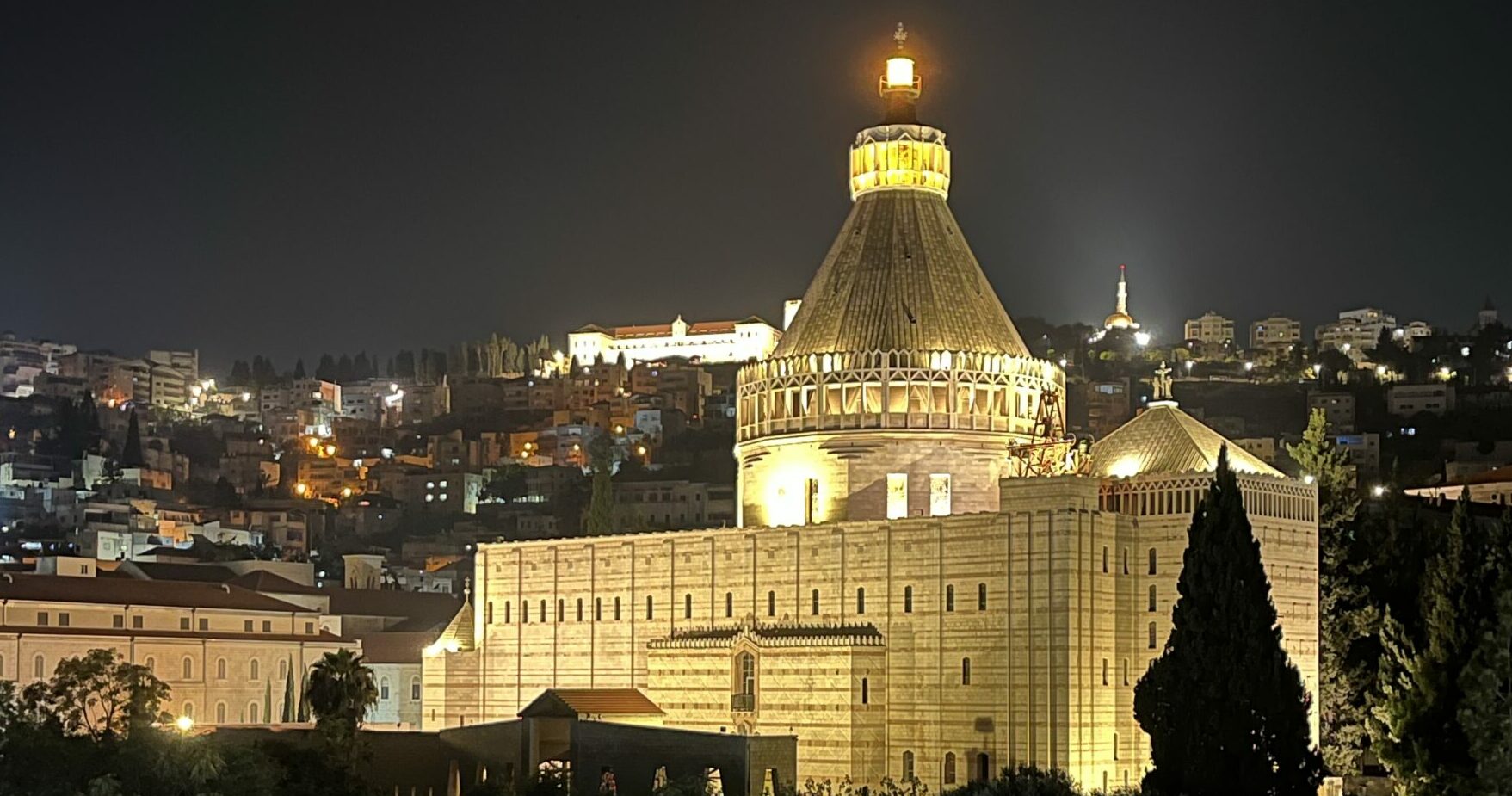We landed on 7 Oct 2023 in Tel Aviv, the Feast of Our Lady of the Rosary. As most of you know, this feast commemorates the Naval defeat of the Turks by the European armies after Pope St. Pius V got all of Europe praying the Rosary for a miraculous defeat. That is exactly what was granted. But just before landing in Tel Aviv five hundred years later, one boy (of our group of 60 pilgrims) saw in the distance smoke coming up from the Gaza Strip from the initial strikes at the beginning of the war.
As we landed, an Israeli woman next to me helped me interpret the news: These bombings were more than the yearly skirmishes in the Middle East. This was going big. As we got off the plane, there was a tense silence as people shuffled past the Arrival/Departure digital boards indicated numerous cancelations at the Tel Aviv airport. Our flight was one of the very last permitted to land before Israel would declare war against Hamas.
We began our pilgrimage where it all began: Nazareth—the Site of the Annunciation and Incarnation. I have a very strong devotion (or rather adoration) to the Incarnation and a great love of the Annunciation. What a great gift it was that I got to see the Church of the Annunciation right from my hotel room. In fact, of our 60 pilgrims, I think I got the room with the closest view of this, the First Mystery of the Holy Rosary. The above picture of the Church of the Annunciation is one I shot that first night of our pilgrimage in the Holy Land.
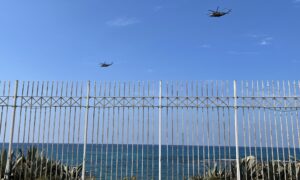
The next day, Sunday, 8 Oct 2023, we went up to Caesarea Maritime. This is the Mediterranean fort built by Herod. It is also where St. Paul was later kept in an underground jail for nearly two years before being shipped off on the Sea to Rome for his final years and martyrdom. Our tour-guides were Palestinian Christians who wanted us to focus on history, not the rumors of upcoming violence. However, when I asked our tour guide if the above military helicopters over the Mediterranean were normal or heightened surveillance, he honestly replied that it was the latter. Also, when I asked if the dozen enormous tanks being shipped down the coast to Gaza was normal defense, he quietly replied that was not normal.
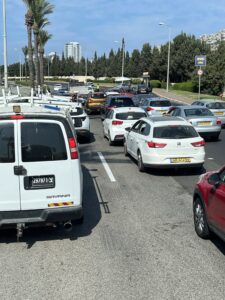
On the way up to Haifa and Mt. Carmel, we came across police check-points, as seen above.
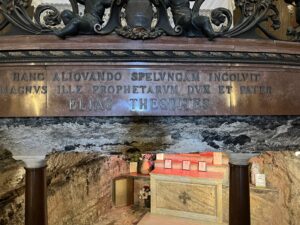
In Haifa (the souther region of the Mt. Carmel area of Israel) is a Carmelite Monastery. Inside the monastery is the cave in which St. Elijah (Elias) hid from the wicked Queen Jezebel. The cave is still there, as seen in the above picture. (Again, Elijah’s cave is inside the currently-habited Carmelite Monastery of women religious.) I have a great devotion to the prophet Elijah for many reasons. One such reason is that the many elderly female enemies against my priesthood have probably been infected with the spirit or demon of Jezebel. St. Elijah shows male prophets how to stay strong in true prophesy, even in the face of female manipulation. Feminism is one of the greatest enemies of Christ’s priesthood, especially in the West today.
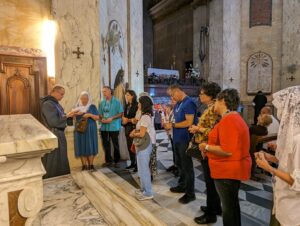
Mt. Carmel was also the perfect place to enroll some of our pilgrims in the brown scapular of Our Lady of Mt. Carmel. As most of you know, the scapular is a mini-religious-habit of the Carmelites. To wear it, one must live chastity (according to one’s state in life) and pray at least five decades of the Holy Rosary daily. Through this commitment, Our Lady promise is that anyone who dies wearing the brown scapular of Mt. Carmel faithful will not go to hell. Furthermore, he or she will be rescued from Purgatory by Our Lady on the Saturday following death. But the scapular is not a magic trick—it’s a two-way commitment.
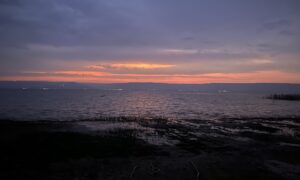
The next day, I had major jet-lag as I woke up in a hotel next to the Sea of Galilee. I was up at 3am. I offered Mass alone at 4am. At 5am, I went outside and prayed my Divine Office before dawn on my phone, as it was still dark (and I couldn’t see my Roman Breviary.) For that hour of praying and hiking around the fountains of the Galilean hotel (in which all 60 of us pilgrims stayed) I heard fighter-jets above me constantly. But there were no explosions or reports. Still, it was clear we were ramping up for something more than a minor-conflict between Muslims and Jews. As the sun came up over the Sea of Galilee (aka Lake Tiberias) I had an overwhelming sense of peace. You can probably sense that peace simply looking at the picture above. That is the body of water upon which the Son of God walked in a storm.
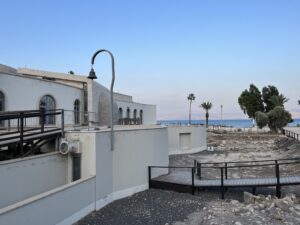
That day, things started to escalate between Hamas and Israel even more. 206 Pilgrimages called from their US headquarters to contact us pilgrimage leaders (Mark Rauguth, Jesse Romero, Fr. Craig and myself) at the Galilean hotel. That was to tell us we had two options: Either 1) Be evacuated from Jordan the next day, or 2) Stay in Israel and risk a delayed return to the United States. It might sound like an easy decision from your point of view right now, but we had only seen signs of war, no explosions or violence (except what the one boy saw far in the distance in Gaza from our plane as we landed in Tel Aviv two days earlier.)
So, that night, we put it to a vote. We explained that US civilian airline carriers had all pulled-out of Tel Aviv. Yes, we all wanted to stay in the footsteps of Jesus and Mary, but we may not get out if we did that. That was the clincher for most of us: We would evacuate to the royal country of Jordan the very next day, as no other flights could be guaranteed to us Americans.
But our bus would not be available until the afternoon, so the next morning, we got a boat ride on the Sea of Galilee and went to the Mount of the Beatitudes, the very center of the ministry of Jesus Christ, the Savior of the World:
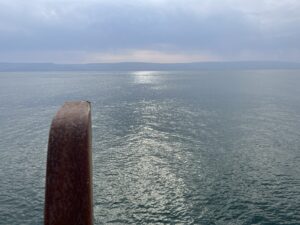
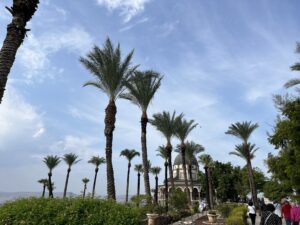
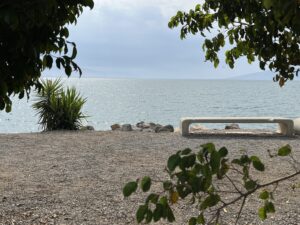
But by the afternoon, it was time to take a bus through the city of Tiberias…
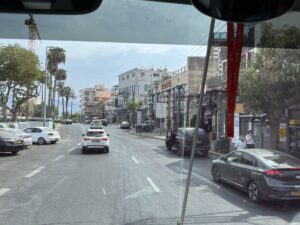
…to the country of Jordan…
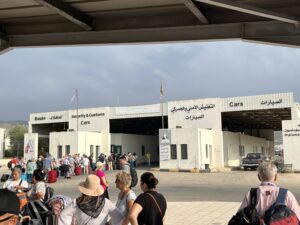
The above is a picture of immigration and customs after crossing the Jordan river from Israel to Jordan. Most of salvation history speaks of “crossing the Jordan” by going Westbound from the desert of Jordan to the land of Israel made of milk-and-honey. This is what Joshua and Caleb did. But one woman went Eastbound from Israel to Jordan: St. Mary of Egypt, and you can find her story in both blog and podcast form on my site. I grabbed the microphone on the bus and talked to our pilgrims about how she went from Jerusalem to the desert of the Jordan to do penance. Our crossing was done in the same direction as her own penitential crossing to find God in the desert.
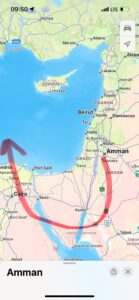
That night, I flew out of Amman, Jordan to Frankfurt, Germany. We should have flown West-Northwest to go from Amman to Frankfurt, but tracking the flight on my phone (there were no seat-computers showing the flight) I saw we went far South before going North, as seen in the arrow I drew on the above map. Why did we fly over Sinai and Cairo? It made sense to me that we avoided the Gaza strip, but why did we avoid the north of Israel? I suspect that’s because there were already rumors of Hezbollah in Lebanon being ready to strike Israel.
In fact, two days later, Syria would bomb Israel from the north. Thus, they routed my plane all the way over Sinai. Did we fly over Mt. Sinai where Moses was given the Law of God? I don’t know, but I know St. Catherine of Alexandria is another one of my favorite Egyptian saints who is buried there on Sinai.
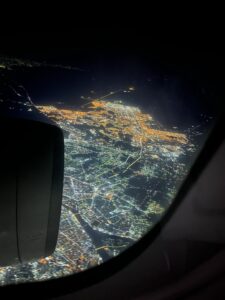
Cairo was the most spectacular city I have ever seen from the air. Most American do not know the Cairo area is the 9th largest megalopolis in the world with over 22.5 million people in the greater metro area. That is bigger than both New York and Los Angeles.
From my time in Israel this week, you can also watch a few of my Talks from the Holy Land.
